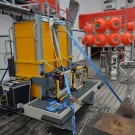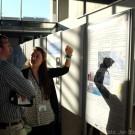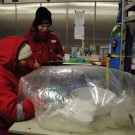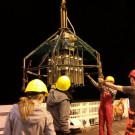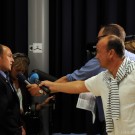On Wednesday, we arrived in Lysekil in Sweden, just in time to enjoy an amazing sunset. Today, on Thursday, we made a day trip to The Sven Lovén Centre for Marine Sciences in Kristineberg, just across the Gullmarsfjord. Together with the partner station in Tjärnö, one hour north of Kristineberg, it is Sweden’s largest […]
Toolboxes at the seafloor
Our ROV (remotely operated vehicle) substitutes our eyes and arms at depth, but the amount of instrumentation it is able to carry (the so-called payload) is limited to the available space and weight of the payload in water since the ROV is kept buoyant by its own floatation (the yellow syntactic foam on the upper […]
Navigators Wochenbericht: Konferenzen, Vorträge und Expeditionen
In der vergangenen Woche präsentierten sich Kiel und die Kieler Meereswissenschaften als gute Gastgeber. Sogar die Sonne schien und die Förde funkelte in wunderbarem Spätsommerlicht, als mehr als 250 Wissenschaftlerinnen und Wissenschaftler aus 35 Ländern zur einwöchigen SOLAS-Konferenz angereist kamen. Sie genossen spannende Vorträge, Workshops und Diskussionen. SOLAS steht für Surface Ocean – Lower Atmosphere […]
About yellow fruits, the ship’s kobold and masculine domains
When I was in Australia a couple of years ago, I booked a dive trip to the Great Barrier Reef. I arrived at the given time at the pier and because the instructor was late, I started a second little breakfast – I ate a banana. A guy showed up with a grin on his […]
Polar suits in the Pacific – sediment sampling for geochemical analyses
¡Hola! We are Seinab and Sophie from Jacobs University Bremen. It is the first big research cruise for both of us and we are excited to be part of it. Instead of looking at sea cucumbers and worms, we work with mud. Here we would like to give an introduction to the geochemical sampling we […]
Looking into the 5%
“To date, we have explored less than five percent of the ocean.” That leaves only the %95 of the ocean to be discovered! You might wonder, which part of this unexplored world we chose to investigate during our “Praktikum auf See” excursion? We started from the Baltic Sea, continue with Danish Strait (Kattegat) and reach […]
How to study small organisms dwelling the seabed
Among all the amazing high-tech equipments that are being used in this SO242/2 Sonne cruise, such as the OFOS (Ocean Floor Observation System), the ROV (Remotely Operated Vehicle) and Landers measuring different environmental conditions at the seafloor, I present you a very traditional equipment used ubiquitously in deep-sea research: the Multicorer, or the MUC, as […]
Hej, Velkommen
Hej, Velkommen, The first day of the trip was a bit of organizing ourselves into teams and tasks: which net has to be taken for each sampling station, how to rinse a flying net, and the most important task, how to communicate with the bridge and the scientists working on deck the same time!!! Luckily, […]
Jellymeters on the Board of RS ALKOR
The sun stands smooth above taking off to the Bornholm Basin. Everybody with a smiley face and ready to start the great adventure. This “Praktikum auf See” is a training course for Master students of biological oceanography at GEOMAR in Kiel. While learning different sampling methods, may these be benthic or pelagic, we will investigate […]
Navigators Wochenbericht: Wissenschaftler im Kameralicht und spannende Vorträge
Wissenschaftler umringt von Kameras und Mikrofonen – kein alltägliches Bild. Vor allem wenn man bedenkt, dass der interviewte Kollege darauf spezialisiert ist, Ozeanströmungen im Computer zu simulieren. Das Thema ist sonst eher schwer zu vermitteln. Ozeanographen, die statt an Deck eines Forschungsschiffes Wind und Wellen zu trotzen vor ihren Computern sitzen, scheinbar unendliche Datenreihen in […]
